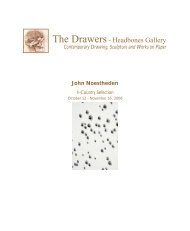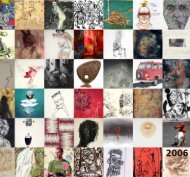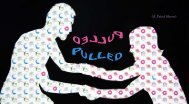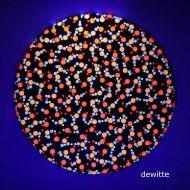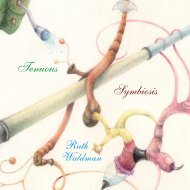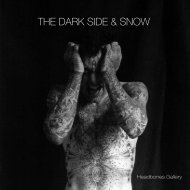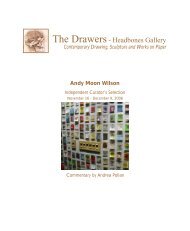Palermo Mummies - Headbones Gallery
Palermo Mummies - Headbones Gallery
Palermo Mummies - Headbones Gallery
Create successful ePaper yourself
Turn your PDF publications into a flip-book with our unique Google optimized e-Paper software.
CYNTHIA KARALLA<br />
Rosalia and The <strong>Palermo</strong> <strong>Mummies</strong>
CYNTHIA KARALLA<br />
Rosalia and The <strong>Palermo</strong> <strong>Mummies</strong><br />
HEADBONES GALLERY
Artist Catalog: Cynthia Karalla - Rosalia and the <strong>Palermo</strong> <strong>Mummies</strong><br />
Copyright © 2012, <strong>Headbones</strong> <strong>Gallery</strong><br />
Photography Copyright © 2002, Cynthia Karalla<br />
Essay © 2011, Eleanor Whitney<br />
Rich Fog Micro Publishing, printed in Canada, 2012<br />
Layout and Design, Richard Fogarty<br />
Printed on the Ricoh SPC 811DN<br />
All rights reserved. No part of this work may be reproduced or transmitted in any form or by<br />
any means, electronic or mechanical, including photocopying and recording, or by any<br />
information storage or retrieval system, except as may be expressly permitted by the 1976<br />
copyright act or in writing from <strong>Headbones</strong> <strong>Gallery</strong>. Requests for permission to use these<br />
images should be addressed in writing to Cynthia Karalla, c/o <strong>Headbones</strong> <strong>Gallery</strong>.<br />
www.headbonesgallery.com<br />
ISBN: 978-1-926605-43-2<br />
Front Cover: 2945<br />
Back Cover: B6865
Rosalia and The <strong>Palermo</strong> <strong>Mummies</strong><br />
Essay by Eleanor Whitney<br />
RICH FOG<br />
Micro Publishing
Rosalia and the <strong>Palermo</strong> <strong>Mummies</strong><br />
Essay by Eleanor Whitney<br />
Rosalia<br />
I spent several years working at a prominent New<br />
York City museum. Included in its encyclopedic<br />
collections were several unwrapped Egyptian<br />
mummies. New York State law prevents the exhibition<br />
of human remains and so they spent their eternity<br />
slumbering in climate-controlled art storage. A<br />
colleague in the collections office took me to see them<br />
during a lunch break, her jingling keys opened door<br />
after door until we found ourselves deep in the<br />
storerooms, far away from the daily museum bustle.<br />
There, on metal shelves, in airtight containers, were<br />
the mummies. Desiccated, shriveled, but overall,<br />
human. I looked at them and tried to wrap my head<br />
around the people I saw in front of me. I leaned in to<br />
look closer. I noticed hair and toenails, the whirls of<br />
skin on the thumb, still intact. I shuddered slightly. My<br />
friend turned to me, “Just remember,” she said with a<br />
smile, “They are friendly mummies.”<br />
Ritual mummification is an ancient tradition that<br />
has been practiced all over the world. Mummification<br />
practices in Ancient Egypt are the most widely known.
The average American middle school student, having<br />
studied Ancient Egypt in world civilizations class, will<br />
proudly tell you that as part of the embalming process<br />
the brain was removed via a hook inserted through the<br />
nose to prepare the body for mummification. <strong>Mummies</strong><br />
have also been found wrapped in intricately woven<br />
textiles in Paracas, Peru, located in the driest region on<br />
earth.<br />
Despite my experience with mummies, I was<br />
unfamiliar with those housed in the Capuchin<br />
Catacombs of <strong>Palermo</strong> until I saw Cynthia Karalla's<br />
photos. What makes these mummies so intriguing is<br />
that they are part of the modern world and recent<br />
history. The contemporary viewer cannot detach from<br />
them the same way one might when looking at a<br />
mummy from Ancient Egypt. The first, and oldest,<br />
mummy in the crypt belongs to the friar Silvestro da<br />
Gubbio, who entered the catacombs in 1599. The most<br />
recent, and most celebrated, mummy is Rosalia<br />
Lombardo, who was 2 years old when she passed away<br />
from pneumonia in 1920.<br />
The crypt at the Capuchin monastery of <strong>Palermo</strong><br />
has over 2,000 mummified bodies on display. Like the<br />
cities of the living, there is some semblance of order in<br />
V4330
V5072<br />
this city of the dead. Bodies are arranged along<br />
corridors or hung in niches in the wall, a hook around<br />
their neck to keep them in place. They are categorized<br />
by profession–clergy members are buried with other<br />
religious practitioners, doctors with doctors, and so<br />
on. The first mummies were created by accident, or by<br />
divine providence, depending who you ask. After years<br />
in the crypts the bodies of monks that been buried<br />
there were found to be intact, instead of decayed as<br />
one might expect. Their preservation was viewed as a<br />
miracle willed by God and the dead monks hailed as<br />
saints. Over time residents of <strong>Palermo</strong> began<br />
employing mummification technologies, leaving less<br />
to chance and God. Early on bodies were left to dry<br />
naturally in the limestone crypts, placed on terracotta<br />
racks to let bodily fluids drain. After several months<br />
the bodies were washed in vinegar, dressed and put<br />
on display. Later chemical embalming procedures<br />
came into vogue. It was embalmer Alfredo Salafia who<br />
used such a process that preserved Rosalia Lambardo<br />
in angelic eternity. Salafia kept the solution for his<br />
popular and effective embalming formula secret and it<br />
was only recently rediscovered and published in<br />
National Geographic.
What, exactly, compelled the residents of <strong>Palermo</strong><br />
to display mummified bodies is up for debate. Some<br />
surmise that the public display of the mummy's<br />
desiccated corpses was the continuation of a pre-<br />
Christian tradition. Others hypothesize that the<br />
mummies are a life-size memento mori, reminding all<br />
what comes next. What is for certain is that the <strong>Palermo</strong><br />
mummies are unique in Italy and throughout the world.<br />
In the crypt the living can walk among the dead, spend<br />
time with them and get to know them a little bit.<br />
As the process of mummification gained popularity<br />
the Capuchin monastery began to sell the residents of<br />
<strong>Palermo</strong> places in the crypt. They promoted a place in<br />
the catacombs as a fashionable and respectable way to<br />
spend eternity. The monks used the proceeds to pay for<br />
the upkeep of the tombs. By the nineteenth century the<br />
crypts became overcrowded and the municipality<br />
passed a law banning the practice of mummification.<br />
Rosalie Lombardo was the last person to enter the<br />
crypt, her body nearly perfectly preserved by Salafia's<br />
embalming formula.<br />
It is usually forbidden to photograph the<br />
mummies. However, Cynthia Karalla obtained<br />
permission to take their portraits over the course of two<br />
V4330
V4557<br />
months. She worked in the catacombs with an assistant<br />
to document the mummies and to showcase their other<br />
worldly glory. Karalla told me a story about how, at the<br />
end of a long day of shooting, the monastery staff forgot<br />
that she was there, and turned off the lights and shut<br />
the door to the crypt. Instead of feeling fright, Karalla<br />
felt a sense of calm and peace, as one would feel in a<br />
church or another place of reverence. In darkness one<br />
can no longer be detached from the reality and eternity<br />
of death.<br />
Not just an interesting or artistic subject matter,<br />
these dead souls have contemporary power. Awestruck<br />
by the mummies, Karalla wanted to give something<br />
back to them. She decided to offer them a glimpse of<br />
contemporary culture. Similar to a photographer who<br />
plays music to entertain their subjects during a photo<br />
shoot, Karalla treated the <strong>Palermo</strong> mummies to the<br />
music of Radiohead and Eminem while she took their<br />
portraits. As she photographed them in their quiet<br />
eternity they appeared to her to be dancing. She<br />
realized that in documenting the mummies she was not<br />
just taking their photos, but providing witness to their<br />
otherwise undocumented lives. Her photographs leave<br />
viewers to wonder about the secrets, experiences, and
wisdom buried in this tomb with these souls.<br />
Karalla's images reveal a particular closeness to<br />
the mummies of <strong>Palermo</strong>. They are portrayed with both<br />
a sense of theatricality and an intimacy that spans<br />
centuries. We can look closely and see their features<br />
still intact–curly hair, lips, teeth, and faces. Through<br />
Karalla's photos these mummies get yet another<br />
chance at eternity, as their likenesses circulate<br />
throughout the world. Karalla captures the irony of<br />
mummies on public display: while they are preserved in<br />
their best clothes, many of which have disintegrated,<br />
and act as clues about our ancestors, we look at them<br />
with modern eyes. These mummies continue to have a<br />
presence in the world of today, even if their lived reality<br />
ended centuries ago. They are both frozen in time and<br />
living beside us, evolving and decaying with us.<br />
Looking at the different inhabitants of the<br />
Capuchin crypt juxtaposed in Karalla's book the viewer<br />
begins to assign personalities and identities to these<br />
mummies. It is the viewer's impulse to give them life<br />
even in death. Karalla's photographs allow us to focus<br />
on the details that reveal the dead to be so close to<br />
us–their crooked teeth, Rosalia's bow and blonde<br />
hair–and how far away from us they seem–skeletons,<br />
V4330
desiccated flesh, twisted faces, and features reduced<br />
to dust. No matter what the state of their bodies,<br />
however, Karalla's photos reveal the nobility, dignity<br />
and soulfulness of these people who have been placed<br />
here purposefully. They are there due to acts of<br />
remembrance, devotion, celebration, and veneration,<br />
as well as a reminder of the end that will eventually<br />
come to us all. Quiet in their repose, at home in death<br />
and modern life, and vividly documented by Karalla,<br />
these too are friendly mummies.<br />
Eleanor Whitney, 2011<br />
V4211
6714
B3854
6758
B4374
V6260
V2868
6988
B4350
B4406
4587
B5866
7351
B3682
3317
V4139
4018
V3790
3989
B4393
V3575
V5736
V3694
V5820
Born Detroit Michigan, 1966-<br />
CYNTHIA KARALLA<br />
Exhibitions<br />
2012 Subtle Slurs, Cynthia Karalla - Fat Lands, <strong>Headbones</strong> <strong>Gallery</strong>, Vernon, Canada<br />
2011 Art Miami 2011, Edelman Arts, New York, USA<br />
Ballarat International Foto Biennale, Australia<br />
2007 The Baby Grand Piano' The Cynthia Corbett <strong>Gallery</strong>, Slick, Paris, France<br />
The Baby Grand Piano' The Cynthia Corbett <strong>Gallery</strong>, Bridge Art Fair, London 07, London, U.K.<br />
Untitled’ (Mona Lisa) Opera Arte e Arti, Matera, Italy<br />
2006 I Santi' <strong>Headbones</strong> Drawers <strong>Gallery</strong>, Toronto, Canada<br />
2005 Visionari Primitivi Eccentrici - 2005 - 2006 - Galleria Civica - Palazzo Loffredo, Potenza, Italy<br />
Rubber Souls,' Digi-Arte 2005, University of Florence, Sesto Fiorentino, Florence, Italy<br />
Busted,' Superlative Exposition, Dekalb Area Women’s Center, Chicago, USA<br />
Baby Grand Intro & Humanity,' Young Willing & Hungry: curated by Andres Serrano at the Jen Bekman <strong>Gallery</strong>, NYC, USA<br />
2004 Rubber Souls & I Santi,' 'Metamorphosis di una citta: architettura contemporanea a Matera, Bari, and Florence Italy / Madrid, Spain<br />
Humanity,' The Underground Art Fair, NYC, USA<br />
Eleven,' Bassel Art Fair, NYC, USA<br />
2003 Madonna in the Chair,' from the Humanity Series, Pels-Leusden Galerie, Zurich, Switzerland<br />
Limmagine della Donna nell,' Arte del 3° Millennio, Ex-Convento delle Suore Pie, Brindisi, Italy<br />
2002 I Santi, a Viso Aperto,' Puglia, Italy<br />
Eleven,' video project. Arteria, Matera, Italy
Exhibitions (cont’d)<br />
2001 'I Santi, a Viso Aperto,' Matera. Sassi, Matera, Italy<br />
Busted Prints,' Because Sex Sells. Nikolia Fine Art, NYC, USA<br />
2000 'The Praying Mass,' The Ukrainian Institute, NYC, USA<br />
Narcy,' (short for Narcissism), Gershwin <strong>Gallery</strong> Space, NYC, USA<br />
1999 The Irony of Ironing,' The Ukrainian Institute, NYC, USA<br />
Karallas Corolla,' 1999 Auto Show at the Javitt Center, NYC, USA<br />
Karallas Corolla,' The Orange Art-car Show, Houston, Texas, USA<br />
1994 Spaces Dressed in White,' The Wall at NYU, NYC, USA<br />
Boyfriends in Rocken Shades,' <strong>Gallery</strong> U, NYC, USA<br />
Virtue = Rebel,' Gubala <strong>Gallery</strong>, NYC, USA<br />
1993 The X-Girlfriend of Marcel Proust,' at The AlleyCat <strong>Gallery</strong>, NYC, USA<br />
Christ,' at E.S.V. Vandam <strong>Gallery</strong>, NYC, USA<br />
Nervous Collector,' The AlleyCat <strong>Gallery</strong>, NYC, USA<br />
Comprachicoes in the Raw,' at The AlleyCat <strong>Gallery</strong>, NYC, USA<br />
1992 Comprachicoes in the Raw,' at The Puck Building Exhibition Space, NYC, USA<br />
1991 'Eat Cake all Natural Ingredients,' National Academy of Arts, NYC, USA<br />
1990 'Layers of Life,' Museum of Contemporary Arts, NYC, USA<br />
Layers of Life,' Soho 20, NYC, USA<br />
Layers,' Synchronicity Space, NYC, USA<br />
Layers,' Under Acme Exhibition Space, NYC, USA
Writings<br />
Present Dilated Pupils,' in the process<br />
1997 The Third World'<br />
1992 'Comprachicoes in the Raw'<br />
Video<br />
2008 More French<br />
2002 The Process<br />
2001 'Eleven' (One minute and Eleven Seconds)<br />
1999 Narcy' (Short for Narcissism) Documentation<br />
2002/03 Eleven,' with a discussion panel<br />
2002 Mary & Jesus,' Backstage, Documenting the last night of shooting the still.<br />
1995 Karalla’s Rolle Back,' Rolle Back Sculpture, Filmed by Tatsushi Tahara<br />
Collections<br />
Museum of Modern Art, NYC, USA<br />
Cooper-Hewitt Museum, NYC, USA<br />
Yokohama Museum, Tokyo, Japan<br />
New York Public Library, NYC, USA<br />
Daniel Katz, London, U.K.<br />
Koc Holding, Istanbul, Turkey<br />
Edward R. Downe Jr, NYC, USA
Publications<br />
2012 Cynthia Karalla, Fat Lands, Rich Fog Micro Publishing for <strong>Headbones</strong> <strong>Gallery</strong>, 58 pages<br />
2007 Pseuds Corner, Private Eye, U.K. No.1195, 12th - 25th October, The Baby Grand Piano<br />
Art Review October 2007<br />
LloydR17;s List by James Brewer R11; December 2007<br />
Bridge Art Fair London 07, p 30. image 'Untitled' (Mona Lisa)<br />
New York Cool, Interview by Anusha Alikhan "Cynthia Karalla Plays The Piano.<br />
2005 Saatchi & Saatchi, Lovemarks German Edition, the art directors cut. Image Rubber Souls 'SunFlower.'<br />
Visionari Primitivi Eccentrici - 2005 - 2006<br />
Citi, Matera, Sept - Interview with Images<br />
The Jewish Post, New York's Best And Worst Art Shows, Volume 31, No. 5, p. 15 & 48<br />
2004 La Gazzetta Del Mezzogiorno, National & Regional, Fotografia moderna,<br />
Un pianoforte fatto di sessi per rompere le barriere fra uomo e donna, Oct 12, 04 p.8<br />
2003 The image of the Woman in the 3rd Millennium Art, Catalog,<br />
Roundtable: Art, Religion and Censorship, Conscience, vol. 24, no. 1, Spring 2003, p. 29<br />
2002 Euorio 7, 2002<br />
MATERaPACIS, 2002 p. Cover, 36 & 37<br />
La Gazzetta Del Mezzogiorno, Sabato 16 Febbraio, E New York scopri I nostri santi<br />
2001 Mathera Luogo non luogo- Materia –Ierofanie<br />
1999 Ukrainian Community Press, Hohol / Gogol: From the Traditional to the Bizarre<br />
1993 Chelsea Clinton News, New AlleyCat for Chelsea. January 28- February 3
RICH FOG<br />
Micro Publishing
HEADBONES GALLERY








